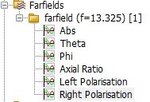panou
Member level 1
- Joined
- Jun 6, 2011
- Messages
- 36
- Helped
- 2
- Reputation
- 4
- Reaction score
- 2
- Trophy points
- 1,288
- Location
- California
- Activity points
- 1,510
Dear friends, :-D:-D:-D
I am still simulating a reflectarray using ring elements. For now I already got the pattern simulation results for the whole reflectarray. I am using rectangular waveguide as the excitation, instead of using feed horn, to simplify the structure.
Now my problem is: how can I simulate the cross-pol level for reflectarray? For example, assuming that the rectangular waveguide is transmitting H-pol EM wave, how can I detect the energy reflected from V-pol in HFSS or CST? I know in chamber I can just put two H, V horns there, one TX and one Rx. But in simulation I dont know how to do this... I searched some posts, one solution is to use microstrip hybrid coupler, which has 4 ports and could give H and V pol.
One more thing, the element is circular ring. So I think the cross-pol level could be defined by both the following:
1. transmit H, receive V for linear pol
2. transmit RHCP, receive LHCP for circular pol
Is that right?
thanks so much


panou
I am still simulating a reflectarray using ring elements. For now I already got the pattern simulation results for the whole reflectarray. I am using rectangular waveguide as the excitation, instead of using feed horn, to simplify the structure.
Now my problem is: how can I simulate the cross-pol level for reflectarray? For example, assuming that the rectangular waveguide is transmitting H-pol EM wave, how can I detect the energy reflected from V-pol in HFSS or CST? I know in chamber I can just put two H, V horns there, one TX and one Rx. But in simulation I dont know how to do this... I searched some posts, one solution is to use microstrip hybrid coupler, which has 4 ports and could give H and V pol.
One more thing, the element is circular ring. So I think the cross-pol level could be defined by both the following:
1. transmit H, receive V for linear pol
2. transmit RHCP, receive LHCP for circular pol
Is that right?
thanks so much
panou
